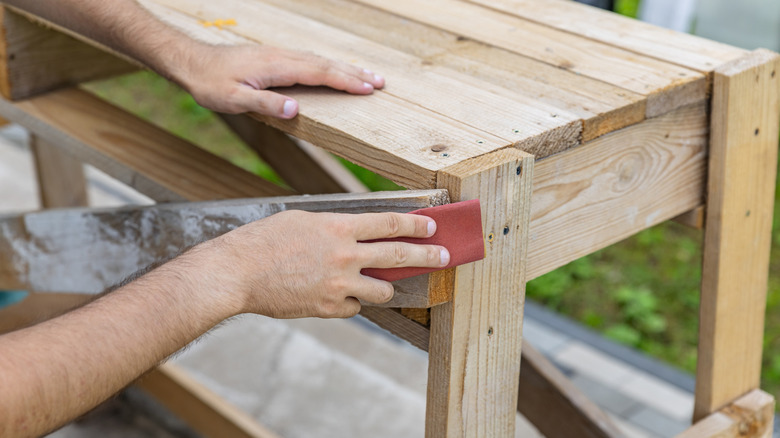Try A Simple Dish Sponge Trick The Next Time You're Sanding
Sanding is an essential part of many home improvement projects, from laying floorboards to refurbishing your wooden furniture. However, it can sometimes feel like a dull, time-consuming chore, especially if you don't have the right tools for the job. While a few sheets of sandpaper can certainly take you far in your DIY pursuits, there are many cases in which you might want to consider picking up a sanding block, an orbital sander, or a set of sanding sponges instead. One particular situation in which sandpaper alone might seem inadequate is when you're sanding down a furniture piece or other wooden surface that has small grooves and edges. For these projects, your can transform a dish sponge into a sanding sponge, which might save you a trip to the hardware store.
To make your own sanding sponge at home, get out a clean and dry dish sponge, and then wrap it in sandpaper. The foam material of the sponge contours the paper around the edges of wood or drywall when you apply gentle pressure. Just as with a normal sanding sponge, it will ensure a smoother, more even finish.
What to consider when using a DIY sanding sponge
You'll see in the video that the homeowner uses this hack to sand down a decorative groove on a door. Using a sanding sponge (whether store-bought or DIY), is one of several clever tricks for painting doors that you might want to try in your own home. However, it can also come in handy in other situations, especially if you're sanding hard-to-reach places, like narrow curves, joints, and edges in wood or drywall.
When you go to purchase a sanding sponge from the store, you might notice that it comes in single and dual-angle varieties. To create a dual-angle one from scratch, choose a thicker, higher-quality dish sponge that doesn't fold easily, so that the base of the tool you're creating stays as balanced as possible. Then, select your first grit, and wrap it around the sponge. For this trick, avoid using the variety of sandpaper that's meant for orbital sanders as @novabay_realestate does in the video above, since it has holes in it. Normal sandpaper will give you a more even result.
Unlike the sanding sponges you can purchase at a hardware store, it's not possible to rinse or wash out the sawdust when following this DIY trick. When the sanding paper begins to wear down, you'll need to replace it with a fresh sheet. If you're going to use your sanding sponge on a regular basis, you might want to consider purchasing one instead of making one, since the store-bought ones are typically washable, and therefore reusable.
